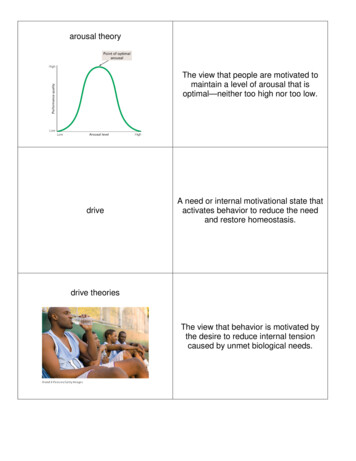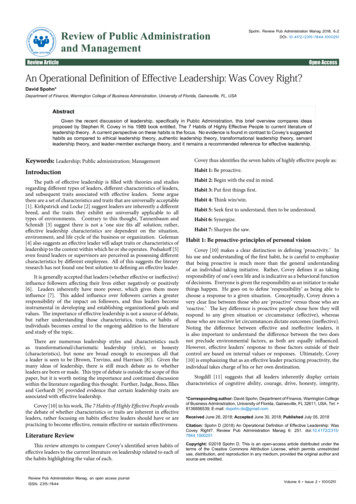
Transcription
arousal theoryThe view that people are motivated tomaintain a level of arousal that isoptimal—neither too high nor too low.driveA need or internal motivational state thatactivates behavior to reduce the needand restore homeostasis.drive theoriesThe view that behavior is motivated bythe desire to reduce internal tensioncaused by unmet biological needs.
homeostasisThe idea that the body monitors andmaintains internal states, such as energysupplies, at relatively constant levels; ingeneral, the tendency to reach ormaintain equilibrium.humanistic theories of motivationincentive theoriesThe view that emphasizes theimportance of psychological andcognitive factors in motivation, especiallythe notion that people are motivated torealize their personal potential.The view that behavior is motivated bythe pull of external goals, such asrewards.
instinct theoriesThe view that certain human behaviorsare innate and due to evolutionaryprogramming.motivationThe biological, emotional, cognitive, orsocial forces that activate and directbehavior.sensation seekingThe degree to which an individual ismotivated to experience high levels ofsensory and physical arousal associatedwith varied and novel activities.
basal metabolic rate (BMR)When the body is at rest, the rate atwhich it uses energy for vital functions,such as heartbeat and respiration.body mass index (BMI)A numerical measure of body fat andweight status based on height andweight.glucoseSimple sugar that provides energy and isprimarily produced by the conversion ofcarbohydrates and fats.
insulinHormone produced by the pancreas thatregulates blood levels of glucose andsignals the hypothalamus, regulatinghunger and eating behavior.leptinHormone produced by fat cells thatsignals the hypothalamus, regulatinghunger and eating behavior.obeseCondition characterized by excessivebody fat and a body mass index equal toor greater than 30.0.
set-point theoryTheory that humans and other animalshave a natural body weight, called theset-point weight, that the body defendsfrom becoming higher or lower byregulating metabolism and feelings ofhunger.achievement motivationThe desire to direct your behavior towardexcelling, succeeding, or outperformingothers at some task.extrinsic motivationExternal factors or influences onbehavior, such as rewards,consequences, or social expectations.
hierarchy of needsMaslow’s hierarchical division ofmotivation into levels that progress frombasic physical needs to psychologicalneeds to self-fulfillment needs.intrinsic motivationThe desire to engage in tasks that areinherently satisfying and enjoyable,novel, or optimally challenging; thedesire to do something for its own sake.self-determination theory (SDT)Deci and Ryan’s theory that optimalhuman functioning can occur only if thepsychological needs for autonomy,competence, and relatedness aresatisfied.
the need to belongThe drive to form and maintain lastingpositive relationships that arecharacterized by mutual concern andcaring.amygdalaAn almond-shaped cluster of neurons inthe brain’s temporal lobe, involved inmemory and emotional responses,especially fear.anthropomorphismThe attribution of human traits, motives,emotions, or behaviors to nonhumananimals or inanimate objects.
basic emotionsThe most fundamental set of emotioncategories, which are biologically innate,evolutionarily determined, and culturallyuniversal.display rulesSocial and cultural regulations governingemotional expression, especially facialexpressions.emotionA complex psychological state thatinvolves a subjective experience, aphysiological response, and a behavioralor expressive response.
emotional intelligenceThe capacity to understand and manageyour own emotional experiences and toperceive, comprehend, and respondappropriately to the emotional responsesof others.interpersonal engagementEmotion dimension reflecting the degreeto which emotions involve a relationshipwith another person or other people.cognitive appraisal theory of emotionThe theory that emotional responses aretriggered by a cognitive evaluation.
facial feedback hypothesisThe view that expressing a specificemotion, especially facially, causes thesubjective experience of that emotion.James-Lange theory of emotionThe theory that emotions arise from theperception of body changes.self-efficacyThe beliefs that people have about theirability to meet the demands of a specificsituation; feelings of self-confidence.
two-factor theory of emotionWarning: not all of the key ideasare on this list of key termsSchachter and Singer’s theory thatemotion is the interaction of physiologicalarousal and the cognitive label that weapply to explain the arousal.
James-Lange theory of emotion The theory that emotions arise from the perception of body changes. self-efficacy The beliefs that people have about their ability to meet the dema










